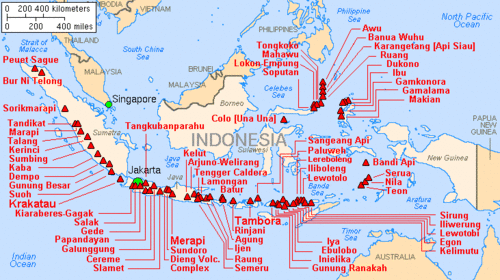Volcanology of Indonesia

Indonesia is a volcanically active country, containing numerous major volcanoes. It has the most volcanoes of any country in the world, with 76 volcanoes that have erupted at least 1,171 total within historical times. The Smithsonian Institution has 141 Indonesian entries in its volcano database.[1] Indonesia has around 130 active volcanoes that are part of the Pacific Ring of Fire, and it has suffered the highest numbers of eruptions resulting in fatalities, damage to arable land, debris flows, tsunamis, lava domes, and pyroclastic flows. Indonesia's most active volcanoes are Kelut and Mount Merapi on the island of Java. The majority of Indonesia's volcano are located on a 3,000 km long chain called the Sunda Arc. Here, the subduction of the Indian Ocean crust underneath the Asian Plate produced most of these volcanoes.[2]
Volcanic Eruptions
The most severe eruptions on Earth in historical times took place in Indonesia. The giant eruption of Mount Tambora, a stratovolcano, in 1815, the largest known eruption in the world during historical times had such a large effect on the climate that for example 1816 in Europe was known as the year without summer, and 40 km3 of ash were produced as a result of the eruption combined with the collapse of the caldera. About 90,000 people were killed as a result Mt. Tambora's 1815 eruption, about 10,000 directly from the eruption and about 80,000 from crop loss and famine.[3] In 1883, the catastrophic eruption of Krakatoa, a volcanic island in Lampung, which registered as a 6 on the Volcanic Explosivity Index (VEI), and the tsunamis that ensued killed about 36,000 people, and approximately two-thirds of the original island was destroyed as well.[4] The 2010 eruption of Mount Merapi, a stratovolcano, began in late October and continued into November. This eruption had a VEI of 4, and it also released a sulfur dioxide cloud between 12,000 and 15,000 km into the upper tropsphere.[5]
Preparation
In 1920, the Volcanological Survey of Indonesia was created in order to investigate, record, and warn people about volcanoes within the Indonesian region. This group has helped aid in the evacuation of people living near Indonesian volcanoes since it was formed. For example, during the 1982 eruption of Galunggung, which had a Volcanic Explosivity Index of 4, 75,000 people were evacuated and 68 people died, and in 1988, 15,000 people were evacuated and there were no fatalities during the eruption of Makian.[6]
See also
References
- ↑ "What country has the most volcanoes?". ask.com.
- ↑ "The Indonesia Region". Smithsonian Institute. 2013. Retrieved October 23, 2016.
- ↑ "How do volcanoes affect people?". oregonstate.edu. Oregon State University. Retrieved October 23, 2016.
- ↑ "KRAKATAU, INDONESIA (1883)". sdsu.edu. Retrieved October 23, 2016.
- ↑ "Eruption at Mount Merapi, Indonesia". NASA Earth Observatory. 2010. Retrieved October 23, 2016.
- ↑ "Tectonics of Indonesia". oregonstate.edu. Oregon State University. Retrieved October 23, 2016.